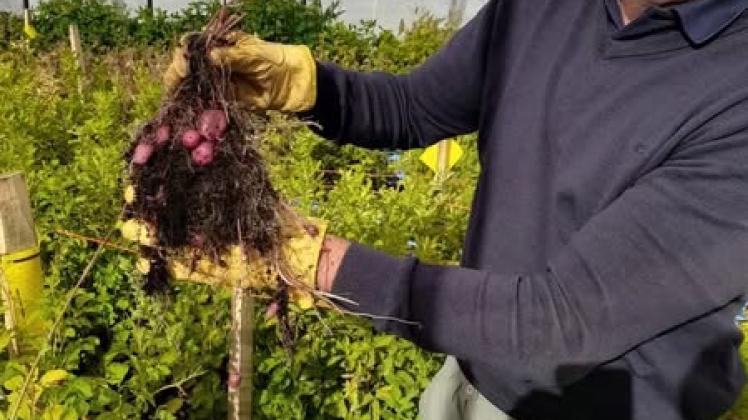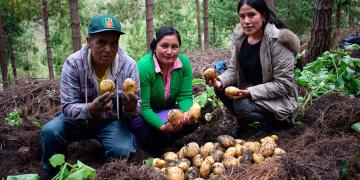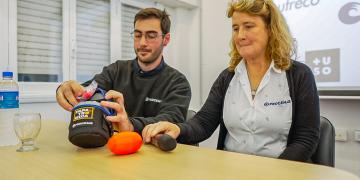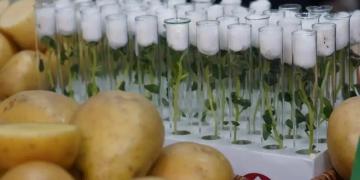Argentina (INTA Mendoza): Two varieties of Andean potatoes adapted to Mendoza soil are being developed.
Researcher Carlos Marfil, from the National Institute of Agricultural Technology, is working with producers in Tupungato on a program to improve this crop.

In 2022, INTA began developing an Andean potato improvement program and is close to registering two varieties adapted to Mendoza. The journey, undertaken jointly with Mendoza producers, began when molecular biologist Carlos Marfil, a researcher at the Mendoza Agricultural Experimental Station, contacted an ancestral producer from Salta while working to recover wild potatoes.
- The Andean potato improvement program involves developing our varieties and selecting those best suited to cultivation in Mendoza soil. One peculiarity of Andean potatoes is that they are relatively unknown to families in Mendoza and Cuyo because they have never been cultivated in this region, as they are adapted to forming tubers in other latitudes.
Andean potatoes come from wild plants and were created through a domestication process that occurred thousands of years ago on all continents, including in the Americas with the potato in Lake Titicaca and corn in Mexico. The crops we see in the grocery store didn’t exist until humans invented them.
But they’re adapted to tuberizing (producing tubers) in short days, which is typical of that latitude, where they don’t have the seasonality we have. There, there are twelve hours of daylight almost year-round, unlike here, where, in summer, when potatoes are grown, the days are long.
The program involves selecting varieties that are productive in these latitudes. Given this, which is the "sine qua non" condition, we focus on other attributes, such as nutritional and nutraceutical properties, which are compounds that are beneficial to health.
- And there are many varieties in Peru to choose from…
- They have nearly 4,000 varieties. It’s immeasurable. We develop our varieties through crossbreeding. A mother plant and a father plant are chosen, and the flowers are crossed. We’re working with varieties from northwestern Argentina, which cover the historical domestication zone.
Andean potatoes migrated from Lake Titicaca north to Venezuela and south to Salta and Jujuy. Since they produce less than the common, modern potato, cultivation never expanded because the market was dominated by yield. And quality and culinary attributes always lagged behind quantity.
- Did Andean potatoes become known for their use in restaurants?
- The boom in the food sector and the fact that they are opinion-forming and visible are a tool for dissemination that they have put at the service of the community. Not only to encourage consumption in their own places, but also to rescue crops that deserve to be rescued. Spreading this knowledge so that, if a family goes to the grocery store and sees it, they can weigh up whether it’s worth spending a few more pesos for a more nutritious and delicious product.
- What health benefits does eating Andean potatoes have?
- They’re potatoes that contain coloring agents, polyphenols, and anthocyanins. We’re used to naming these molecules in the wine industry. And these colorful potatoes possess these antioxidant properties, which are beneficial for the circulatory system.
The first thing, as I said, is that the varieties we develop must form tubers and achieve good yields in the province. But we’re also looking to develop colored potatoes that contain these health-promoting compounds. Another attribute we’re adding is to begin evaluating their suitability for industrialization, because not every potato is suitable for industrial production. There are certain parameters they must meet. And we’re adding these analyses with the aim of achieving what other countries do: marketing colored potato chips.
- In which areas of Mendoza does cultivation grow well?
- At INTA, we have conducted trials in Uspallata, La Carrera (Tupungato), and Drummond (Luján), and in all three locations, the tubers are successful and produce good yields. Now we need to sustain production in the medium term and continue these trials to increase reliability and characterize the variety in different environments over the years. We can do this thanks to the partnership with producers who plant our varieties on their farms.
- How many varieties have you developed so far?
- The breeding plan includes dozens of varieties. We’ve preselected two so far, and the plan is to register them in the National Cultivar Registry to give them an identity. It’s also a tool for promoting their cultivation. It encourages producers to know they exist and acquire and plant them.
- How did the program come about?
- I was developing another one, on in situ conservation of wild potatoes—the ancestors of Andean potatoes, prior to domestication—which are very valuable genetic resources for improving cultivated potatoes. They are found throughout the Andes mountain range, but they aren’t food. They grow naturally, and I was leading this initiative at the Faculty of Agricultural Sciences, on in situ conservation of these species in natural areas.
We began our work with the Argentine desert potato, which grows in Mendoza, San Juan, La Rioja, and Catamarca. We have a genetic reserve in the Villavicencio Nature Reserve. The research spread nationally, and we continued it in Los Cardones National Park (in Salta), near the Andean potato domestication area.
It’s an area rich in ancestral treasures: wild potatoes. While we have only one species in Mendoza, there are dozens in the northwest. It’s a priority site for establishing a wild potato genetic reserve. We began working on a project, and that led us to connect with the local people and share our learning.
That’s how we met Elba Colque, a resident of Los Cardones National Park and an ancestral Andean potato grower for generations. Learning about her story and her garden inspired me to work with this crop. The goal is to rescue these ancestral varieties, which producers have maintained for centuries, and expand the growing regions in Argentina.
Fuente: losandes.com.ar









